Shattuckite Gemstone: Properties, Meanings, Value & More
 Shattuckite is a copper gemstone beloved for its often vibrant shades of blue to blue-green coloring. The unique name comes from the location of its discovery.
Shattuckite is a copper gemstone beloved for its often vibrant shades of blue to blue-green coloring. The unique name comes from the location of its discovery.
Is shattuckite rare? Very rare. Usually, you’ll find it mixed with other stones like quartz, malachite, or chrysocolla.
In the healing realm, shattuckite is renowned for its high spiritual energies and association with metaphysical fields of work.
Thinking of buying some shattuckite jewelry, decor, or healing stones? Stay tuned as we break down all the info you need to know about shattuckite gemstones, from their properties to prices and everything in between. Let’s get into it!

About Shattuckite Stone
Shattuckite is a semi-precious gemstone in greens and blues, ranging from dark navy to vibrant cobalt blue. The only alternate moniker for the stone is “Lunazul,” given to Congo shattuckite specimens presented at the 2015 Tucson gem show.
Now, at first glance, you may confuse shattuckite for chrysocolla.
But is chrysocolla a shattuckite? No, though they share some similarities (and key distinguishing differences) that we’ll dive deeper into in a bit.
Turquoise also shares similarities with shattuckite, making shattuckite an often brighter-colored alternative to turquoise as one of the traditional December birthstones.
On its own, shattuckite is a beneficial zodiac stone for all earth signs — Taurus, Virgo, and Capricorn — along with all water signs — Cancer, Scorpio, and Pisces. That means half of the twelve zodiac signs can carry this gorgeous gem for good luck!
On a mineralogical level, what type of stone is shattuckite?
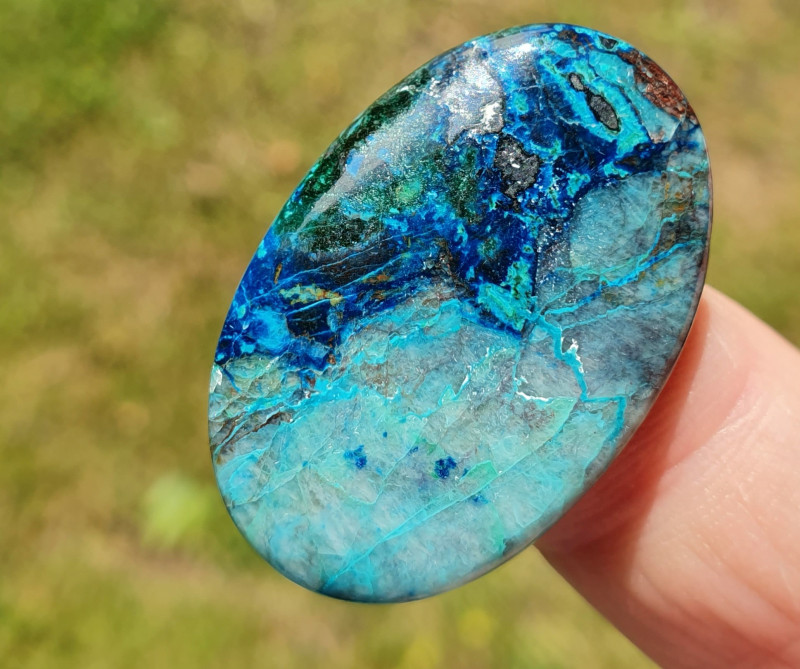
Shattuckite Specifications & Characteristics
The mineral shattuckite is a copper silicate hydroxide with the formula Cu5(SiO3)4(OH)2. It has a high copper content and joins similar copper silicates like malachite, chrysocolla, and azurite.
The crystal structure and look of shattuckite is very similar to plancheite. Plancheite is a similarly rare copper silicate with a range of blue hues, though its greens are usually paler than those of shattuckite. The easiest distinguishing test is by hardness, as plancheite has a Mohs hardness of 6.
Shattuckite’s density is somewhat unique in being oddly high for a mineral without metallic elements.
You’ll usually find shattuckite in the form of granular masses, spherical aggregates, or fibrous acicular (needle-like) crystals. The spherical aggregates can often be made up of these acicular crystals. The mineral can also be botryoidal (like a grape cluster), grainy, or globular.
Here are the remaining shattuckite mineral properties:
Mohs hardness: 3.5
Color: Shades of blue, green, and/or blue-green; Sometimes patterned with white, reddish-brown, or black
Crystal structure: Orthorhombic
Luster: Dull to silky
Transparency: Translucent to opaque
Refractive index: 1.75-1.81
Density: 4.1
Cleavage: Very good/Distinct, 2-directions on [010] and [100]
Fracture: Uneven to splintery
Streak: Blue
Luminescence: Usually none, sometimes weak light blue fluorescence in SW-UV
Pleochroism: Present in very light blue, light blue, and deep blue
Before we can wrap up mineralogy, let’s go over how to tell shattuckite apart from similar stones like chrysocolla, malachite, and turquoise.
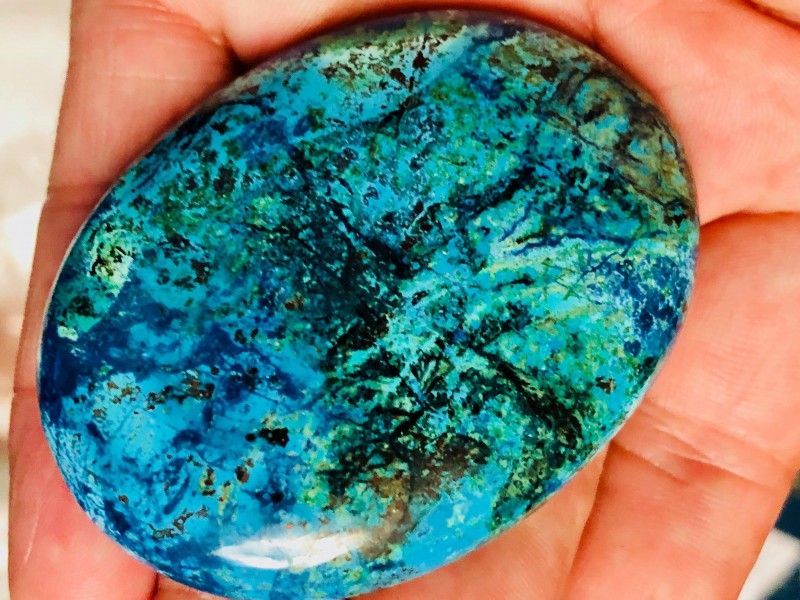
Shattuckite vs. Similar Gemstones
Some gems get confused based on their names, others by their similar coloring. In some cases, multiple gems can even have similar compositions — even more confusing, they can grow together! This is the case for shattuckite with malachite, azurite, chrysocolla, and turquoise.
So, how do you tell them apart? Specific coloration and hardness are two key factors.
Often, the hardest distinction is shattuckite vs chrysocolla.
They both can have vibrant blues and greens, they often grow together, and they can both have similar additional colors in their pattern such as white or red.
Plus, shattuckite can resemble chrysocolla chalcedony (a.k.a. “gem silica”) to make things more confusing. However, chrysocolla chalcedony (a variety of chalcedony) has a greater Mohs hardness (at 6.5-7) than chrysocolla or shattuckite, which both land around 3.5.
Your best bet for making a definitive distinction is having an experienced professional run tests to determine the stone’s composition.
Malachite and azurite are easier to distinguish from shattuckite. Malachite is solely green, while azurite is solely blue. That said, malachite and azurite may mix together to create a blue and green patterned stone called azurmalachite.
Both azurite and malachite have a slightly lower density (at 3.6 to 4.0) than shattuckite (at 4.1), but the difference is slim. At a crystalline level, azurite and malachite are monoclinic while shattuckite is orthorhombic.
Lastly, turquoise vs. shattuckite is arguably the easiest distinction. Turquoise has a greater hardness (5-6), paler color, and a triclinic crystal structure.
With mineralogy done, let’s shift over into shattuckite’s mystical and historical side.
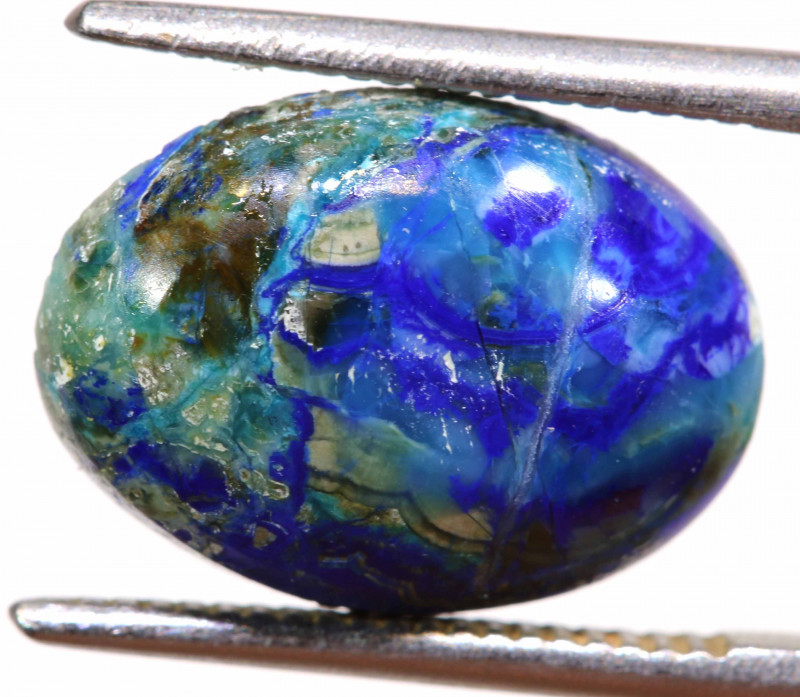
Shattuckite Meaning & History
Shattuckite symbolizes intuition, psychic communication, and truth. It’s said to be a helpful companion for those in spiritual or foretelling fields like tarot reading, clairvoyance, and astrology interpretation. Some call it the “Psychic Communication Stone.”
Another spiritual nickname for shattuckite is the “Stone of Truth.” Not only does it represent honesty in a literal sense, but it also represents living authentically, aligning your actions with your values.
The first official discovery of shattuckite occurred in 1915. Waldemar T. Schaller found the original specimens in the Shattuck Mine located in Bisbee, Arizona, USA, and named the stone after the location. Schaller was an American mineralogist and served as Chief Mineralogist of the United States Geological Survey.
You may recognize Schaller from his discoveries and valuable descriptions of such gems as dumortierite, gillespite, and purpurite, to name a few.
For almost a century, the Shattuck Mine was the sole producer of shattuckite. Around 2003, miners started finding shattuckite in other locations like Namibia and Congo, among others.
With more shattuckite available to collectors and crystal healers, what is shattuckite used for now?
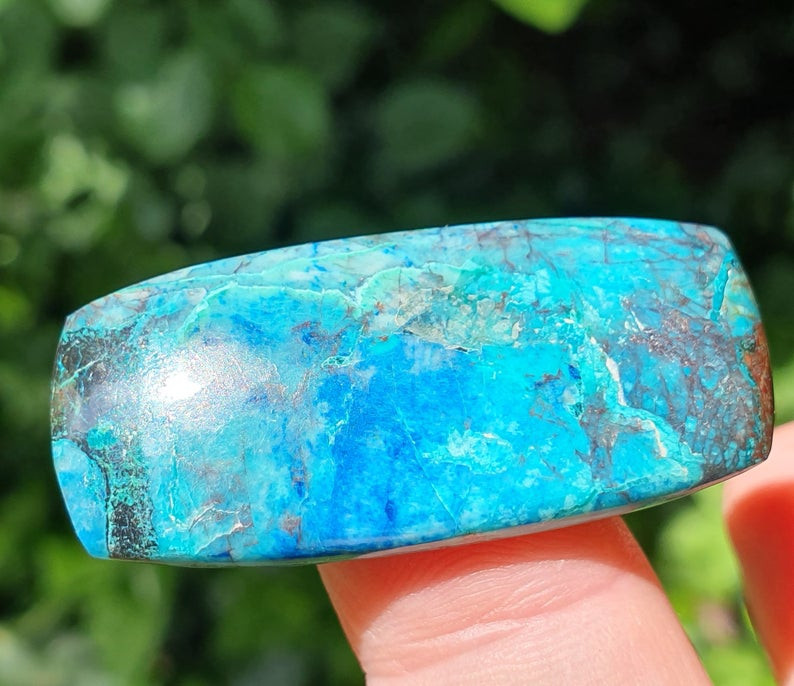
Shattuckite Healing Properties
Gems like shattuckite can function as healing stones, with some of their powers tied to their coloring. The green hues in shattuckite bring the vitality, growth, and luck inherent to green gemstones.
What is blue shattuckite good for? Blue shattuckite benefits reflect those of other blue gemstones, bringing soothing, peaceful, and confidence-boosting energies.
Plus, shattuckite joins other blue crystals in being a chakra stone for the throat chakra, facilitating honest communication and authentic understanding of your true self. This is especially helpful for those who work in communication-forward fields like education and journalism.
Now, what about other shattuckite uses for emotional, physical, and spiritual healing?
Physical Healing
Some of shattuckite’s purported physical benefits include:
Treating cell or DNA damage from radiation
Preventing illnesses
Helping heal thyroid, blood, or spleen issues
Balancing acid levels
Treating diabetes and tonsillitis
Emotional Healing
Shattuckite crystals are said to provide protection and healing from past emotional wounds. During trying times, healers believe the stone infuses the wearer with resilience, wisdom, and emotional balance.
Relationship-wise, shattuckite is believed to promote harmony, especially after fights. It purportedly helps lower aggression, impulsivity, and hypercriticism. The “Stone of Communication” instead facilitates honest yet compassionate expression of one’s truth.
Spiritual Healing
Shattuckite is incredibly spiritual, perfect for connecting with your own spiritual self through meditation and establishing a foundation for spiritual growth.
Additionally, this crystal is believed to sharpen your intuition and awareness of wisdom from beyond, helping you understand yourself and the world from a new perspective. If you’re looking to harness powers for psychic communication or other metaphysical abilities, shattuckite is the best companion to help you hone these skills.
Looking beyond its role as a healing stone, how do we judge shattuckite’s value as a gemstone?

Shattuckite Gemstone Properties
Shattuckite’s value as a gemstone relies on where it falls on color, cut, clarity, size, and treatments.
Color
Shattuckite’s copper content is behind its blue to green hues, similar to the copper minerals azurite and malachite. Higher amounts of copper in shattuckite (sometimes from mixing with other copper minerals like the ones we’ve mentioned) can lead to deeper hues.
Stones with vibrant coloring, interesting patterns, and/or a lack of less attractive hues (like brown, white, or black) are most valuable. These unattractive colors often come from other minerals like calcite or dioptase.
Additionally, shattuckite can lend its colors to other colorless crystals. Most often, you’ll see it layered underneath quartz to form beautiful blue quartz druzy. You may also see shattuckite malachite, shattuckite azurite, or shattuckite chrysocolla mixtures.
Cut
The softness and cleavages of shattuckite make faceted cuts difficult and thus rare, so faceted shattuckite gemstones are highly valuable. The proper faceting can display the stone’s high dispersion (colorful sparkle) well in light-colored, translucent specimens.
More often, you’ll see shattuckite cut as cabochons or beads. It may also be sold as raw crystal specimens, particularly druzy pieces.
Clarity
Clarity describes the amount of visible inclusions in a stone. In most translucent stones, inclusions will decrease the value. However, the bright inclusions of malachite, chrysocolla, or azurite can cause mesmerizing patterns that may increase shattuckite’s value.
Size
Being rare, shattuckite in larger sizes is already more valuable. Cabochons can be multiple inches long, but may be pricier than smaller-sized options.
Treatments
Shattuckite may be treated with resin to give it greater stability and durability.
With grading done, let’s learn about shattuckite’s origin before it reaches the jeweler.

Shattuckite Formation & Sources
Shattuckite forms as a secondary mineral, meaning it starts as a different mineral.
Usually, secondary minerals start as primary minerals that formed inside crevices of its host rock as that rock was forming. Next, the host rock goes through metamorphic changes, the primary mineral alters too, becoming a new secondary mineral.
Shattuckite is somewhat unique in that it starts as other secondary minerals — in this case, those secondary minerals transform into shattuckite. Oftentimes, you’ll see shattuckite form from malachite.
You’ll find shattuckite in oxidized areas of copper deposits.
Mining Locations
Where can I find shattuckite? Besides the original Arizona (USA) locale, other sources of shattuckite include:
Argentina
Austria
Chile
DR of Congo
Germany
Great Britain
Greece
Mexico
Namibia
Norway
South Africa
Before you start shopping, what prices should you expect for shattuckite?
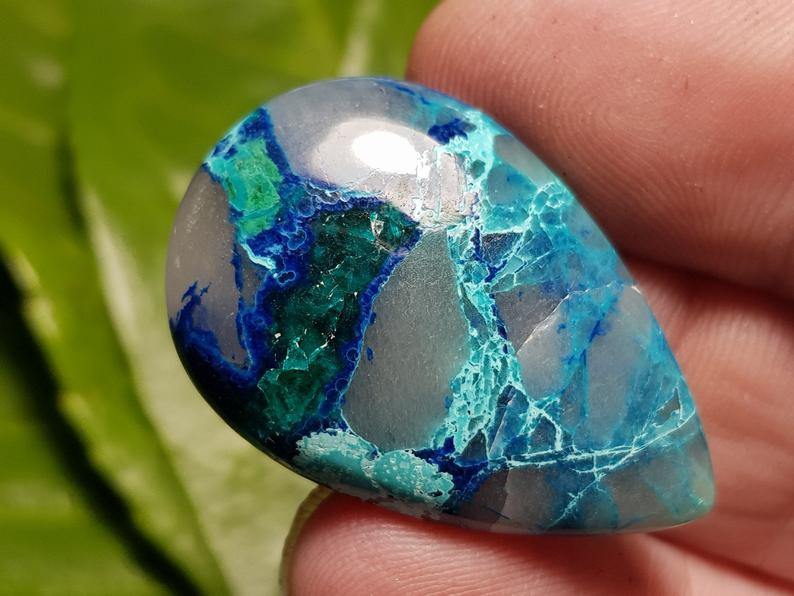
Shattuckite Price & Value
The most valuable form of shattuckite is faceted gems, which are usually around $20-$30 per carat.
At wholesale, shattuckite cabochons with more vibrant coloring and patterns range from $1-$4 per carat. Lighter-hued cabochons range from $0.30-$1.50 per carat.
Prices for raw shattuckite vary widely. Druzy can reach $1,800 at wholesale, but other rough specimens start at $5 and can reach upwards of $2,000 or even $29,500 in some cases. Spheres are similarly broad in price, fetching prices of $8 to $300 or higher.
Shattuckite jewelry at wholesale is much more affordable, with earrings costing around $15 for each pair. Pendants tend to be $20-$40 each.
Shattuckite Care and Maintenance
Before we wrap up, it’s important to know proper gemstone care. We recommend protective settings for any shattuckite jewelry to prevent scratches or breakage.
It’s important not to clean shattuckite with any chemical-heavy products. Simply washing the stone with warm water and mild soap, possibly giving it a light scrub with a soft toothbrush when needed, will do the trick.
Store shattuckite separately from other gems.
If you’re using shattuckite for crystal healing, do NOT use it in elixirs or ingest it in any form, as the copper content is toxic.
Shatter Illusions with Shattuckite!
By look alone, shattuckite reminds us of a brilliant view of Earth from space with its vibrant green and blue portions. But this “Stone of Truth” offers an equally objective view of our true selves and the world’s truth.
Wearing or keeping a shattuckite stone close ensures you can understand your true desires and values, living them out authentically everyday.
Buy shattuckite gemstones today!
Was this article helpful?
Ross Sedawie
- Written - 12th Aug 2022
- Edited - 30th Nov 2023
















